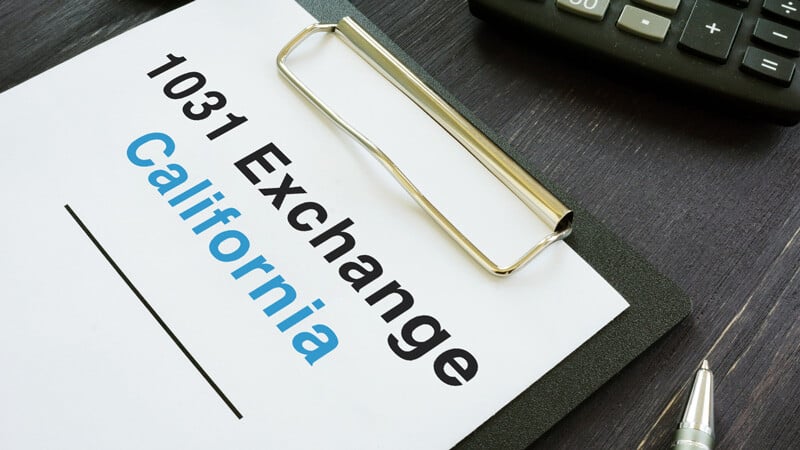
California has some of the highest capital gains taxes of any state. For this reason, investors are vulnerable to high tax liabilities following the sale of properties.
Fortunately, there’s a way for you to defer taxes after you sell an investment property in California, and it’s through a 1031 exchange.
A 1031 exchange is a valuable tool for putting off capital gains tax payments. Also known as a “like-kind” exchange by the IRS, it can benefit you greatly whether you’re looking to expand your real estate portfolio or simply have better cash flow for your investment goals.
There are several considerations that can affect how you approach 1031 exchanges in California.
1031 Exchange Rules in California
There is not much difference in the idea behind 1031 exchanges in California and elsewhere.
In California, basic 1031 concepts like similar-purpose properties and the use of a qualified intermediary apply.
Even the IRS’s timelines govern every like-kind exchange in California.
With that said, the state has its own rules and regulations that impact 1031 exchanges, adding a layer of complexity to your exchanges.
Like-Kind Property in California
The concept of “like-kind” property under federal law remains consistent in California. This means that as long as the property you’re selling and the property you’re buying are both held for investment or business purposes, they are considered like-kind.
However, in California, you must be cautious when exchanging properties across state lines. If you sell a California property and exchange it for one in another state, the state will track the deferred gain and apply taxes when you eventually sell the out-of-state property.
The same state capital gains tax laws may still be in effect even if the state where the new property is located doesn’t have similar tax rules.
State-Specific Filing Requirements
On top of form 8824, California requires additional filing obligations beyond federal requirements.
For instance, investors must file California Form 3840, This form is the California Like-Kind Exchanges form, and it’s where investors report the exchange and track the deferred state tax.
As a California investor, you must file this form because it allows the state to monitor any future tax liabilities arising from the deferred gain. Form 3840 is particularly critical in scenarios where your replacement property is located outside California.
Failure to comply with these filing requirements could result in penalties or a disallowed deferral, which could lead to unexpected tax bills.
Compliance With Franchise Tax Board (FTB) Regulations
The California Franchise Tax Board (FTB) enforces strict compliance with state tax laws concerning 1031 Exchanges.
Investors must ensure that all transactions and filings align with FTB regulations. Among the regulations are maintaining thorough records of the exchange, ensuring that all timelines are met, and understanding the specific tax obligations that California imposes on these transactions.
Ignoring or misunderstanding these state-specific rules can lead to significant tax consequences. For this reason, it’s in your best interests to work with tax professionals who are well-versed in both federal and California tax laws.
Tax Implications in California 1031 Exchanges
While the primary benefit of a 1031 exchange is the deferral of federal capital gains taxes, California’s tax rules add another layer of complexity to your exchanges, significantly impacting the outcome of the transaction.
Capital Gains Taxes in California
California is one of many states that levy a capital gains tax for property sales. The state also has some of the highest rates of any state requiring capital gains taxes.
At roughly 13%, the rates in the state can result in a larger tax bill for many investors.
Deferred State Taxes in a Like-Kind Exchange in California
In a 1031 Exchange, the primary tax benefit is the deferral of capital gains taxes. However, while the federal government allows this deferral, California imposes additional rules.
When you exchange a property located in California, you can defer state capital gains taxes, just like you would defer federal taxes. However, California’s tax deferral is not permanent.
The state enforces a “claw-back” provision, which means that if you eventually sell the replacement property and it’s located outside California, the state will reclaim the deferred taxes.
This provision can lead to significant tax liabilities down the road, particularly if you’re moving your investments out of state.
Depreciation Recapture Taxes
Another important tax consideration in California is depreciation recapture. Depreciation recapture occurs when the IRS and California Franchise and Tax Board reclaim the benefits you received from depreciation deductions during the ownership of the property.
In a typical 1031 exchange, the capital gains tax is deferred while the depreciation recapture tax is not. California follows the federal rules on depreciation recapture, which means you’ll need to account for this when calculating your potential tax liability.
The depreciation recapture rate can be as high as 25% at the federal level, and you’ll also owe taxes to California based on the state’s tax rates.
The result is a significant tax bill, especially if the property was held for a long time and significant depreciation deductions were claimed.
Potential Tax Liabilities
California has high capital gains tax rates and numerous state-specific tax details. As a result, even with a 1031 exchange, there are still potential tax liabilities that may still arise in the state.
For instance, if you fail to comply with the specific rules and deadlines associated with a 1031 exchange, the transaction could be disqualified, leading to immediate tax consequences.
Also, if the replacement property is sold in a taxable transaction or if the property no longer qualifies as a like-kind property, the deferred taxes become due.
Or imagine reporting your exchange on the IRS’s 8824 Form but forgetting to do the same on your California Like-Kind Exchanges Form. Your error can lead to the invalidation of your exchange, significantly higher tax obligations, and even penalties.
Understanding these risks and working with a qualified intermediary and tax professional can help mitigate the potential for unexpected tax liabilities.
By working with a qualified intermediary or QI who’s knowledgeable of 1031 exchange rules in California and at the federal level, you can be less likely to encounter penalties and maximize the benefits of your 1031 exchange.
Things To Consider for Out-of-State Exchanges
Because of California’s high capital gains taxes, many investors seek replacement properties out of state. While doing this won’t invalidate the 1031 exchange, it does add another layer of complexity to an already nuanced process.
Should you choose an out-of-state 1031 exchange from California, here are several things you need to consider.
California’s Claw-Back Provision
One of the most significant considerations in out-of-state exchanges is California’s “claw-back” provision.
Here’s how a claw-back provision works in a 1031 exchange.
When you sell a property in California and reinvest in a property located in another state, California allows you to defer state capital gains taxes at the time of the exchange. However, if you later sell the out-of-state property, California will reclaim the deferred taxes.
This provision means that even though you may have exchanged your California property for one in a state with no income tax, you’re still liable for California state taxes when the replacement property is eventually sold.
The California Franchise Tax Board (FTB) closely tracks these transactions, and you must report the exchange on California Form 3840. This task is required to enable the state’s tax authorities to enforce its claim on the deferred taxes.
Tax Implications of Out-of-State Investments
California’s tax deferral applies during an out-of-state 1031 exchange, but be aware that the eventual tax implications can be significant.
If you move the proceeds from a California property into a property in a state with lower or no income taxes, you might expect a reduced tax burden. However, California’s ability to enforce the claw-back provision means you’ll still face California tax liabilities even if the new property is in a tax-friendly state.
This can be detrimental to your long-term investment strategy, particularly if your goal is to minimize overall tax exposure.
Different states also have varied rules on property taxation and capital gains, which could further complicate your tax situation when it comes time to sell the replacement property.
Multi-State Filing Requirements
One of the challenges of state-to-state 1031 exchanges is that you’ll need to file multiple tax returns. You’ll have to file your tax returns in California and the state where your replacement property is located, and state rules regarding 1031 Exchanges can vary.
Besides complying with California’s tax reporting requirements, you may also need to adhere to the state tax laws where the replacement property is located.
Failure to comply with these multi-state filing obligations can result in penalties. Worse yet, the tax-deferred status of your California 1031 Exchange can become invalidated.
What To Do as an Investor in California
Moving capital to a state with lower taxes might seem advantageous, but the impact of California’s claw-back provision could diminish those benefits.
For this reason, working with a tax advisor who understands both California’s specific requirements and the tax laws of the state where the replacement property is located is vital. This ensures that your investment strategy aligns with your financial goals and helps you navigate the complexities of multistate exchanges without incurring unexpected tax liabilities.
Deadlines and Timelines in a California 1031 Exchange
As in any other state, there are strict deadlines for any link-kind exchange in California.
Meeting the strict deadlines and timelines associated with a 1031 Exchange is crucial for maintaining the tax-deferred status of your transaction. In California, failing to meet these deadlines can invalidate your 1031 exchange, resulting in a hefty tax bill.
45-Day Identification Period
The first critical deadline in a 1031 Exchange is the 45-day identification period. Here’s how it works:
From the date you sell your relinquished property, you have exactly 45 days to identify potential replacement properties. This identification must be in writing, signed by you, and delivered to the appropriate parties involved in the exchange, such as the qualified intermediary.
California follows the federal rule that allows you to identify up to three potential properties regardless of their value. You’re also allowed to select an unlimited number of properties as long as their combined value doesn’t exceed 200% of the value of the relinquished property.
If you miss this deadline, your exchange can be disqualified, resulting in immediate tax consequences, so be careful in your planning.
180-Day Exchange Period
The second key timeline is the 180-day exchange period, which starts on the same day as the sale of your relinquished property.
Within 180 days, you must complete the purchase of one or more of the identified replacement properties. This period is inclusive of the 45-day identification period. This means you have a total of 180 days from the sale of your original property to finalize the exchange.
If the deadline falls on a weekend or holiday, it does not extend the deadline. Rather, the transaction must be completed within the original 180-day timeframe.
In California, failure to adhere to this timeline can result in disqualification of the exchange. The result is the immediate recognition of all deferred capital gains and depreciation recapture taxes.
Extensions and Exceptions
There are no exceptions to the IRS’s 1031 exchange rules in California when it comes to deadlines. As soon as you’ve sold your original asset or investment property, you’ll immediately trigger the 45-day rule and must identify replacement properties within the said timeline.
From here, you’ll have no more than 180 days to close your purchase on one or several of the replacement properties you’ve identified.
While the timelines are strict, there are limited circumstances under which the IRS may grant extensions. Some examples include cases of natural disasters or other extenuating circumstances.
However, these extensions are rare and usually require specific IRS approval.
Why You Should Work With a Qualified Intermediary
To ensure these deadlines are met, you must work with a qualified intermediary (QI). This is an individual or third party who facilitates the exchange by holding the proceeds from the sale of the relinquished property and then using those funds to purchase the replacement property.
The QI ensures compliance with the strict 1031 Exchange rules, including adhering to the 45-day and 180-day deadlines.
In California, choosing an experienced QI who understands both federal and state-specific requirements can be the difference between a successful exchange and a costly mistake.
Procedural Considerations
When conducting a 1031 exchange in California, you must follow a process. The process involves several critical steps, each governed by specific regulations that must be followed to maintain the tax-deferred status of the exchange.
1. Working With a Qualified Intermediary
Before you undertake the exchange, it’s a good idea to consult and work with a qualified intermediary or QI.
The QI acts as a middleman, facilitating the exchange by holding the proceeds from the sale of your relinquished property and then using those funds to purchase the replacement property.
Under IRS’s 1031 exchange rules, you cannot directly receive the proceeds from the sale because this would invalidate the exchange and trigger immediate capital gains taxes. The QI ensures that the transaction remains compliant with both federal and California-specific regulations.
2. Document the Exchange
Proper documentation is another critical aspect of a 1031 Exchange. This includes contracts, identification letters, and closing statements — all of which must be meticulously prepared and maintained.
California has specific filing requirements, such as Form 3840, which tracks the deferred gain if the replacement property is out of state.
3. Adhere to the IRS’s Timelines for 1031 Exchanges
Adhering to the 45-day identification period and the 180-day exchange period is mandatory, and failing to adhere can invalidate your exchange’s tax-deferred status.
To avoid potential legal issues, work closely with your QI, real estate agent, and legal advisors to ensure that all timelines are strictly followed.
Key Takeaway: Work With Qualified Professionals Throughout Your California 1031 Exchange
Given the complexity of California 1031 Exchanges, working with experienced legal and tax professionals is a must.
These experts can guide you through the legal requirements, ensure that all procedural steps are correctly followed, and help you navigate any challenges that arise.
They’re also critical when it comes to drafting and reviewing contracts, managing compliance with California’s specific regulations, and addressing any legal issues that may occur during the exchange process.
By partnering with knowledgeable professionals, you’ll be less susceptible to costly mistakes and ensure that your 1031 Exchange is both legally and procedurally compliant.
The tax and estate planning information offered by the advisor is general in nature. It is provided for informational purposes only and should not be construed as legal or tax advice. Always consult an attorney or tax professional regarding your specific legal or tax situation.
Sources:
https://www.irs.gov/forms-pubs/about-form-8824
https://www.ftb.ca.gov/forms/2023/2023-3840.pdf
https://www.ftb.ca.gov/file/personal/reporting-like-kind-exchanges.html
https://www.investopedia.com/terms/d/depreciationrecapture.asp



